Western Fox Snake (Pantherophis ramspotti)
Alternate names: Western Foxsnake
by Jeff LeClere
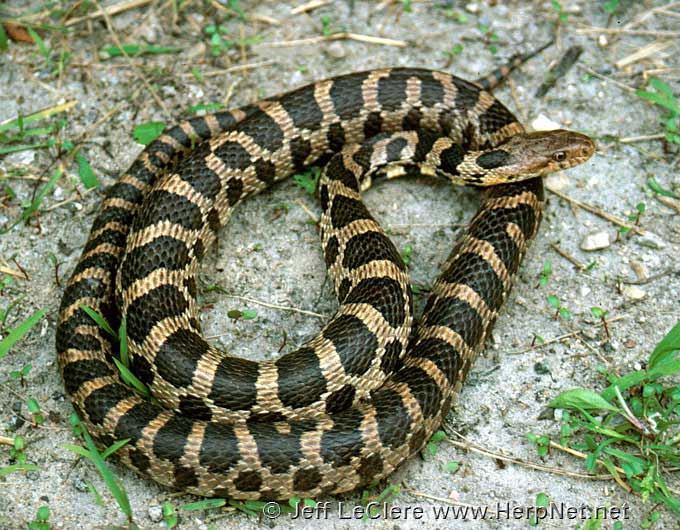
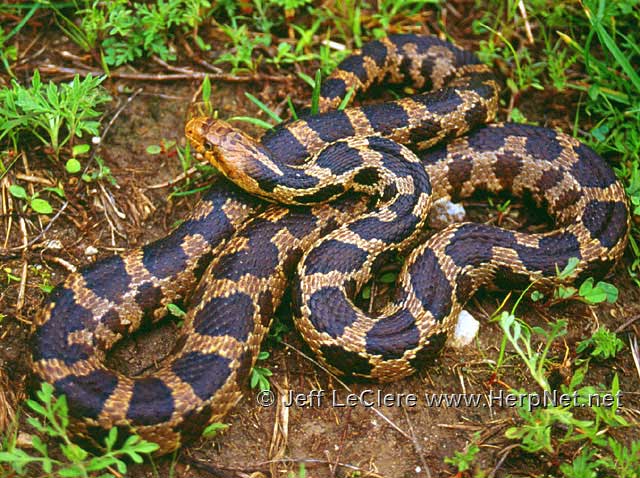
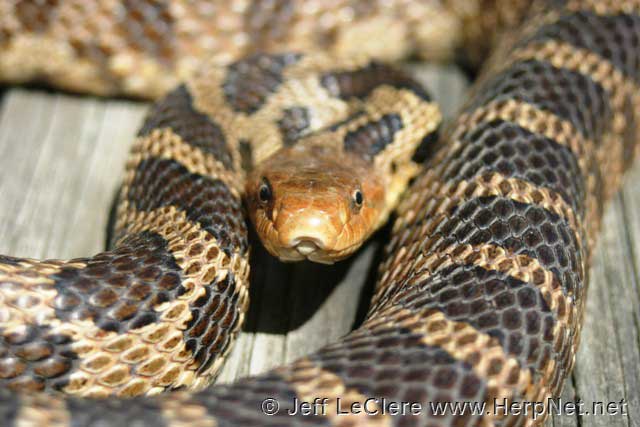
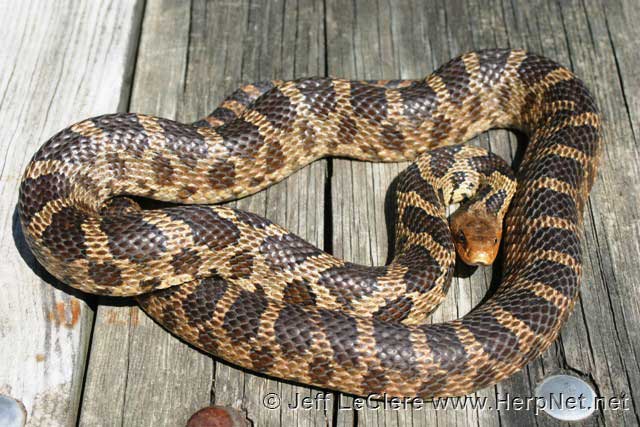
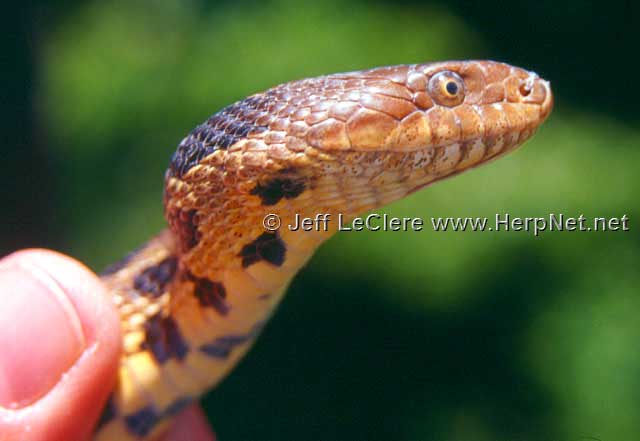
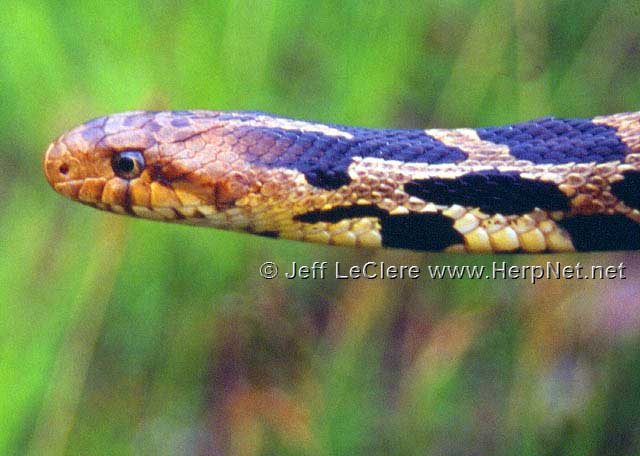
Status
PROTECTED and Species of Greatest Conservation Need. It is illegal to kill or collect this species by law in Iowa. Common throughout all of Iowa, they are protected under state law. Former names include Mintonius ramspotti, Elaphe vulpina.
Description
Harmless to humans. Measuring 36 – 56 inches in length, this is one of Iowa’s larger species of snake (Conant and Collins, 1991). Ground color ranges from straw yellow to dark brown. Occasionally, there may be orange, yellow, or reddish pigment between the scales. There are large distinct body blotches that are very dark brown or black. These blotches become rings on the tail. The head may be light brown with yellow, orange, or reddish highlights and is usually unmarked except for a small design on top. The belly is a dirty yellow with black checkering.
Young western fox snakes are noticeably lighter than adults, having a light brown or gray ground color and lighter body blotches with black outlining. The head is usually boldly marked with black lines, the most conspicuous of these being the line that travels diagonally from the eye to the angle of the jaw and the line on top of the head connecting the eyes. As with all North American rat snakes, the scales are weakly keeled (poorly defined keels on the dorsal scales and smooth lateral scales) and the anal plate is divided. A few hybrids between bullsnakes and western fox snakes have been found in Madison and Linn counties Iowa, Wabasha County Minnesota, and an unverified report from Illinois (LeClere et al. 2012; Pinto et al. 2018).
Subspecies
No subspecies are currently recognized.
Range
The western fox snake is the most common constricting snake in most parts of Iowa and occurs throughout the state. A number of south central counties appear to have lower numbers of western fox snakes as perhaps the more diverse feeding habits of prairie kingsnakes may out compete western fox snakes.

Habitat
This snake occupies more moist habitats than other large Iowa snakes. Woodland and woodland edges, prairies, lowland meadows, and rocky outcroppings near rivers provide food, shelter, and overwintering sites for western fox snakes. They are especially common in river and stream valleys. Western fox snakes adapt more readily to human habitations and habitat disturbance. Often, they are found well within the city limits of even the largest Iowa cities. Ironically, some city ordinances may ban the keeping of constricting snakes under their dangerous animal law, even though the western fox snake, a constrictor, is found there naturally!
Habits
Western fox snakes are active during the day, especially in the spring, but often again in the fall as well. During the hot summer months, western fox snakes choose to move about at night, just like many other Iowa snake species. When encountered, western fox snakes are usually very passive opting to flee even when cornered. When handled, they usually do not strike or bite, but they may release a mild musk from their scent glands at the base of the tail. The musk apparently smells like that of a red fox (Vogt, 1981). More excitable specimens, especially juveniles, will coil and strike with a short, forced hiss (LeClere, 1996). They will also vibrate their tails producing a rattling or buzzing sound. This behavior often causes them to be misidentified as rattlesnakes, bullsnakes, and, because of their copper-colored head, copperheads. They are often killed because of this.
Bullsnakes (which are harmless) have a much more pointed snout than western fox snakes and a single anal plate. Iowa’s timber rattlesnakes have thin, black bands (not spots) across the body and have a rattle at the end of their solid black tails. Western fox snakes, however, have large, dark spots on the body, no rattle, and the tail is not solid black. Copperheads have a very restricted range in Iowa, and copperheads are much more orange in overall coloration without any dark brown or black spots.
Western fox snakes emerge from winter dormancy in April and are active until October. They overwinter in rocky crevices or man-made structures that extend below the frost line (Jessen, 1993). They mate in spring. Females are oviparous and lay about 10 – 20 eggs. The young hatch in August and are about 8 – 12 inches in length. A female western fox snake from Johnson County laid 12 eggs on 3 July. The eggs ranged from 37 – 46 mm. The eggs hatched on 12 August; an incubation period of 40 days at approximately 80 degrees F. The young measured from 273 – 342 mm total length at hatching. Another female western fox snake from Louisa County laid 8 eggs on 5 July. The eggs averaged 42 mm. The eggs hatched 16 August; an incubation period of 42 days at about 80 degrees F. The young measured from 282 – 344 mm total length at hatching.
These snakes spend most summer days beneath debris that retains the suns warmth. They are strong snakes and can climb with ease. However, most prefer to travel along the ground. They also swim well and make use of this ability. Many western fox snakes have been found crossing rivers or well away from the shores of ponds or lakes (Breckenridge, 1944; LeClere personal observation). Western fox snakes may travel a great deal during the active part of their season. Many of these snakes are hit by automobiles as a result of their frequent road crossings and because they may bask on the road for warmth (Breckenridge, 1944, Oldfield and Moriarty, 1994, Jessen and LeClere, personal observation). Males are often hit in the spring, and females are often hit during egg laying season as they search for suitable sites to lay their eggs. In the fall, neonates traveling to their hibernacula are most often hit by automobiles (Blasus and LeClere, personal observation).
Food
Western fox snakes are valuable consumers of rodents, which make up the bulk of their diet. This snake belongs to the rat snake group and is a powerful constrictor. Young western fox snakes may feed on frogs or young mice (Oldfield and Moriarty, 1994). Adults have been known to eat birds and their eggs (Vogt, 1981). I found a large female crossing the road in Le Sueur County, Minnesota at dusk with bird feathers hanging from the corners of her mouth and a large lump in her stomach.